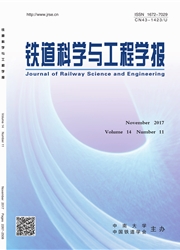

 中文摘要:
中文摘要:
结合沪宁城际铁路建设项目进行数值计算研究,通过分析不同施工阶段对紧邻运营铁路产生的影响,确定基坑开挖为路基最危险阶段;以最危险阶段为模型,计算得到列车通过速度以及停靠对开挖路基影响不大,路基状态主要受基坑开挖深度影响,而雨水浸泡则会导致路基强度与变形发生较大变化甚至失稳,必须加强雨后对路基的防护;计算得到的极限破坏状态变形、动力响应等参量阈值可作为路基状态评价的标准.
 英文摘要:
英文摘要:
The research of numerical calculation was conducted, combining with the Shanghai - Nanjing intercity railway construction project. This paper analyzed the influence of different construction stages on adjacent operating railway, and determined that foundation pit excavation was the most dangerous period for roadbed stability; Taking the most dangerous stage as a model, the calculation results show the train speed and stop cause no big impact on the roadbed excavation, while the state of subgrade is mainly influenced by excavation depth, and the rain soak would result in substantial change for the subgrade strength and deformation or even lead to instability, thus strengthening the subgrade protection after the rain is a must. The threshold values, such as the deformation and dynamic response calculated under limit failure state, can be regarded as the standard for evaluation of subgrade state.
 同期刊论文项目
同期刊论文项目
 同项目期刊论文
同项目期刊论文
 Numerical Investigation of Stress Concentration Phenomenon in Piled Embankment underMoving Train Loa
Numerical Investigation of Stress Concentration Phenomenon in Piled Embankment underMoving Train Loa Analytical solution of undrained cylindrical cavity expansion in saturated soil under anisotropic in
Analytical solution of undrained cylindrical cavity expansion in saturated soil under anisotropic in Analysis on pile-soil stress ratio of composite foundation with sparse capped-pilesunder lime-soil e
Analysis on pile-soil stress ratio of composite foundation with sparse capped-pilesunder lime-soil e Effects of shear strength reduction strategies on safety factor of homogeneous slopebased on a gener
Effects of shear strength reduction strategies on safety factor of homogeneous slopebased on a gener hree-dimensional dynamic analyses of track-embankment- ground system subjected to high speed train l
hree-dimensional dynamic analyses of track-embankment- ground system subjected to high speed train l A simplified approach for negative skin friction calculation of special-shaped pile considering pile
A simplified approach for negative skin friction calculation of special-shaped pile considering pile Three-dimensional dynamic analyses of track-embankment- ground systemsubjected to high speed train l
Three-dimensional dynamic analyses of track-embankment- ground systemsubjected to high speed train l Analytical solution of undrained cavity expansion in saturated soil under anisotropic initial stress
Analytical solution of undrained cavity expansion in saturated soil under anisotropic initial stress A Theoretical Analysis of the Bearing Performance ofVertically Loaded large-Diameter Pipe Pile Group
A Theoretical Analysis of the Bearing Performance ofVertically Loaded large-Diameter Pipe Pile Group 期刊信息
期刊信息
